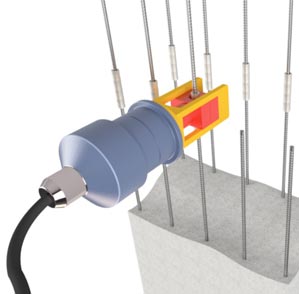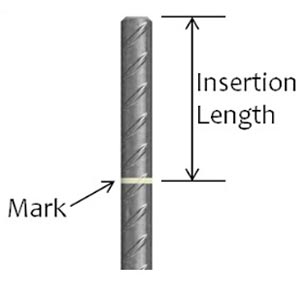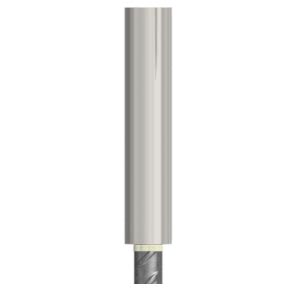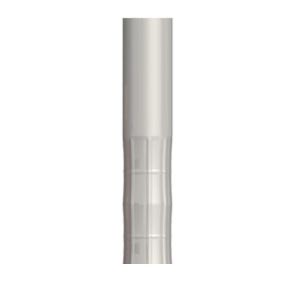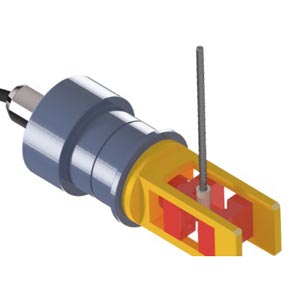In-Place Swaged Couplers
Rolled Threaded Couplers Categories
CSST – Transition Coupler
The CSS-T Coupler functions in a similar manner to the CSS Coupler but is used when the bars to be connected have different diameters. This feature allows the mechanical connections to be assembled in locations that experience abrupt variation in bars’ sizes especially at beam-column, and column-column connections.
General Information
NEW CONSTRUCTION OR REPAIR
The cold-swaged splicing method is suitable for a wide variety of applications including new construction, on-site repair work or strengthening of existing structures. The simplicity and robustness associated with this method makes it suitable for all construction projects.
STEEL BAR PROPERTIES ARE MAINTAINED
The mechanical characteristics and geometrical properties of the steel bars are maintained intact throughout the installation process without the need to expose the bars to heat or to perform unnecessary cutting operations.
SPECIAL PREPARATIONS ARE NOT REQUIRED
The swaging process is conducted in-place without the need to rotate the bars. If the bars are epoxy coated according to ASTM A775, then it is not required to shield or remove the epoxy coating prior to installing the coupler.
OUTSTANDING PERFORMANCE LEVELS
INCON Cold-Swaged coupling sleeves can be used in all applications where Type 2 couplers are required. Bar strength and splice integrity are maintained under both static and dynamic loads until b
INCON ADVANCED THREADING TECHNOLOGY
Cold-swaged mechanical splices are performed by deforming the coupling sleeves around the ends of the spliced bars using INCON’s portable swaging machine to obtain structural integrity. Bars to be spliced are inserted into the coupling sleeve a sufficient distance to ensure that perfect mechanical interlock is achieved between them. One of the great advantages is that swaging can be performed in-place without the need to carry out special preparations on the reinforcing bars regardless of their surface treatment. Bars of the same size or different sizes can be connected with the suitable coupler type. INCON’s portable in-place swaging machine is innovatively designed to accelerate the workflow while enhancing the structural integrity of the mechanical splice. Its lightweight, simple operation and high durability are key features to complete the required task quickly and efficiently. It can be used under all weather conditions and to perform work under the most challenging construction constraints.
.
IN-PLACE INSTALLATION PROCEDURE:
STEP 1:
Ensure that the reinforcing bars are clean from any dirt or grease before proceeding. Then, place a mark on each bar to indicate the required insertion length based on the technical data.
STEP 2:
Insert INCON coupling sleeve into the reinforcing steel bar with the guidance of the placed mark.
STEP 3:
Using INCON’s portable swaging machine, exert pressure on the coupling sleeve according to the recommended values detailed in the technical data.
STEP 4:
Ensure the coupling sleeve is crimped over the entire bar embedment length in order to develop the required mechanical interlock.
STEP 5:
Align the second bar with the existing connection and apply required pressure over the other portion of the coupling sleeve.
WHY INCON’S IN-PLACE COUPLERS?
INCON Cold-Swaged Couplers integrate durability; structural performance and cost effectiveness to provide our valuable clients with state-of-the-art products and services that satisfy all their needs during the construction of new structures or rehabilitation of existing ones.
Structural Performance
- Full strength of the reinforcing bars is maintained up to 100% of their specified tensile strength.
- Alteration in the bars’ cross-sectional areas and mechanical properties are avoided.
- Ductile behavior in the structural members is maintained.Structural performance
- is independent of concrete type and strength.
- Slip is completely eliminated between couplers and the embedded steel bars.
- Bars are concentrically aligned resulting in direct force transfer between the two bars.
Construction Simplicity
- The coupling sleeve is compatible with all deformed steel bars.
- No special preparation is required for connecting epoxy coated or galvanized steel bars.
- Installation of the mechanical splice requires only INCON’s portable swaging machine.
- Congestion of steel reinforcement is significantly reduced.
- Formwork damage is avoided during construction of wall-slab connections.
- Substantial reduction in the number of laborers needed for cut and bend works.
Cost Effectiveness
- Remarkable saving in material and labor cost.
- Savings in steel cost and welding material, especially for long splices.
- Reduction in time required for preparing detailed drawings and calculation sheets for lap splices.
- Reduction in inspection time for lap splices and bent bars during the construction phase.
- The need for operating heavy pieces of equipment is not required on site.
Quality Control
- INCON Cold-Swaged couplers are manufactured in accordance with the strictest Canadian standards in ISO certified and UKAS accredited facilities.
- Both experimental and analytical investigations are performed on our products to ensure outstanding structural performance that exceeds the requirements provided in major building codes and standards.
- In addition to our research and development program, INCON has been working in collaboration with Western University in Canada to continuously develop the quality of our mechanical splicing devices.
Environment
- INCON splicing devices are recyclable and can be manufactured of recycled materials.
- Reinforcement waste associated with lap splices is significantly reduced.
- Noise pollution associated with threading of steel bars on site is significantly reduced.
- No welding or heating required in production process or site applications.



